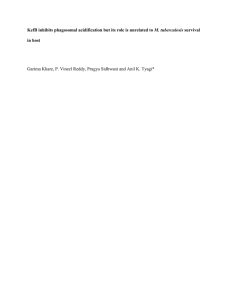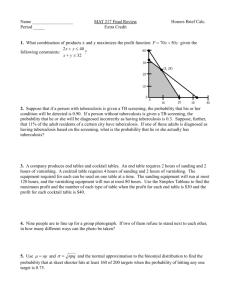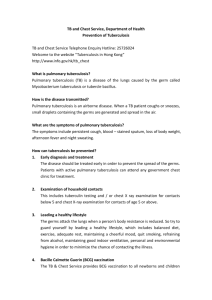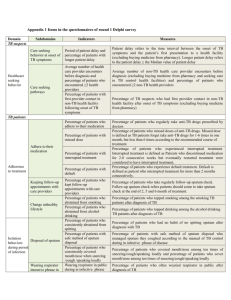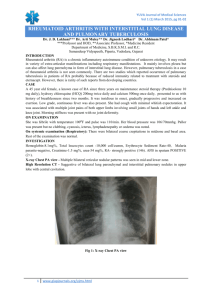349-1771-1
advertisement
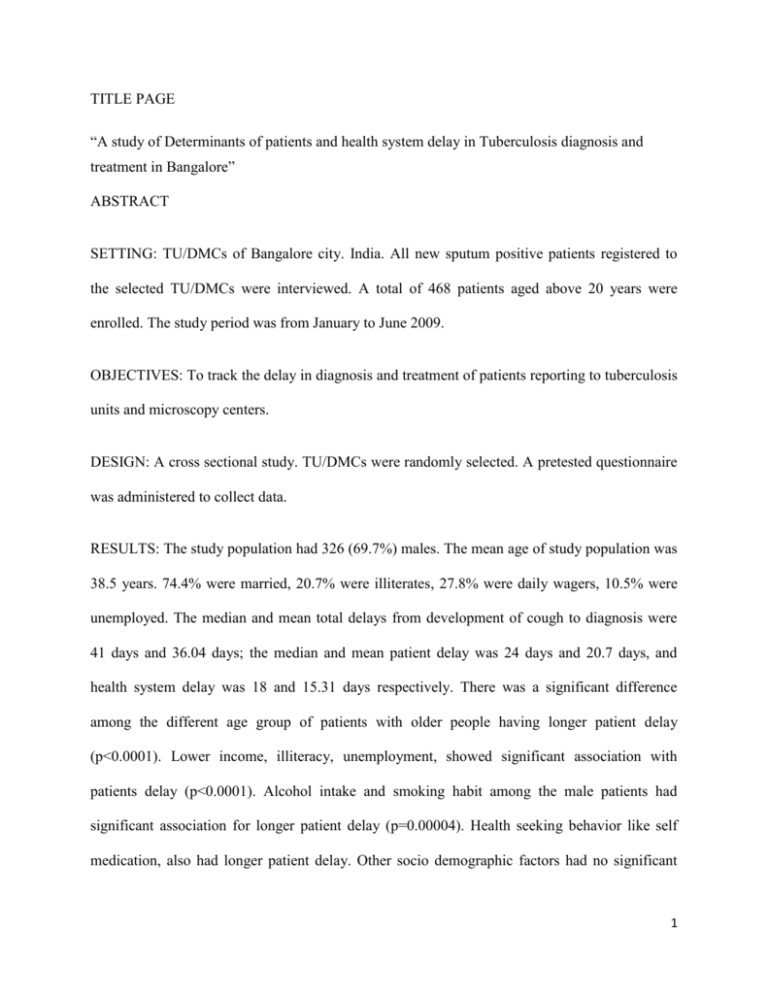
TITLE PAGE “A study of Determinants of patients and health system delay in Tuberculosis diagnosis and treatment in Bangalore” ABSTRACT SETTING: TU/DMCs of Bangalore city. India. All new sputum positive patients registered to the selected TU/DMCs were interviewed. A total of 468 patients aged above 20 years were enrolled. The study period was from January to June 2009. OBJECTIVES: To track the delay in diagnosis and treatment of patients reporting to tuberculosis units and microscopy centers. DESIGN: A cross sectional study. TU/DMCs were randomly selected. A pretested questionnaire was administered to collect data. RESULTS: The study population had 326 (69.7%) males. The mean age of study population was 38.5 years. 74.4% were married, 20.7% were illiterates, 27.8% were daily wagers, 10.5% were unemployed. The median and mean total delays from development of cough to diagnosis were 41 days and 36.04 days; the median and mean patient delay was 24 days and 20.7 days, and health system delay was 18 and 15.31 days respectively. There was a significant difference among the different age group of patients with older people having longer patient delay (p<0.0001). Lower income, illiteracy, unemployment, showed significant association with patients delay (p<0.0001). Alcohol intake and smoking habit among the male patients had significant association for longer patient delay (p=0.00004). Health seeking behavior like self medication, also had longer patient delay. Other socio demographic factors had no significant 1 influence on the patient delay. Longer health system delay was found among patients who visited general practitioners and Ayurvedic medicine. CONCLUSION: More specific and effective health education of the general public on tuberculosis and seeking of appropriate medical consultation are likely to improve case detection. 2 Introduction Tuberculosis (TB) is a world wide pandemic. India has the largest number of infections with over 1.8 million cases1. Two of every five Indians are infected with the TB bacillus. Of them, 10% will develop TB disease during their lifetime. Every day, about 5,000 people develop the disease and around 1000 die. Every year, almost 1.8 million new cases occur in the country, of which almost half are infectious2. Early diagnosis and prompt initiation of treatment is essential for an effective tuberculosis control programme. Delay in the diagnosis may worsen the disease, increase the risk of death and enhance tuberculosis transmission in the community3. The contagion parameter suggests that where TB is endemic each infectious case will result in between 20 and 28 secondary infections4. A person with active but untreated tuberculosis can infect 10-15 other people per year5. Although individual TB cases are effectively diagnosed and treated, incidence continues to increase in many settings. A plausible reason for this is that there are prolonged delays from the onset of TB disease in individuals to the time of eventual diagnosis. During such delays an active case may infect numerous susceptible people there by contributing to the perpetuation or expansion of the epidemic6. With this background this study was proposed to measure patients and health care provider delay as well as to analyze factors associated with delays in TB diagnosis and initiation of treatment among patients reporting with cough of 3 week or more to Tuberculosis Units/ Designated Microscopic Centers (TU/DMCs). 3 Methods and Methodology: A cross sectional study was conducted during January-June 2009 in Bangalore urban area. 3TU and 12 DMCs were randomly selected out of 8 TU and 50 designated DMCs. All new sputum positive patients aged above 20 years registered in the selected TU/DMCs were enrolled for the study. On an average each selected TU/DMC will register 6-8 new sputum positive patients per month and the total sample size at the end of 6 months were 468. Data collection: A pre tested semi structured questionnaire was used to collect the required data. The first part is filled based on the records of the TU/DMCs after the subjects had undergone the investigations and diagnosed as new sputum positive cases. The second part was regarding the socio-demographic profile of the study subjects. The third part included information regarding the health seeking behavior, self medication used, distance travelled to reach the health facility. The DOTS providers and paramedical workers were given training on how to administer and collect information from the study subjects. Cross checking with the accompanying relatives of the subjects confirmed all the information on socioeconomic status and health seeking behavior. Wherever possible, past prescriptions were also examined to validate the information. Definitions of variables used: a. Patient Delay: Time interval between appearance of cough and first contact with a medical facility (Government hospital/private hospital/general practitioner etc.) b. Health System delay: Time interval between first contact with the facility and confirmation of diagnosis and initiation of anti-tuberculosis treatment. c. Total Delay: Sum total of patient and system delays. 4 Analysis Data was analyzed using Epi-info2002. Patient delay was dichotomized using a cut off value of 30 days and health system delay was classified into 3 groups as 1-15 days, 15-30 days and more than 30 days. In the absence of any international/ national norms for acceptable delay, this study used subjective criterion based on presence or absence of symptoms. Chi-square test was used to determine the association of variables. Results: Socio demographic profile of study population: A total of 468 new sputum positive tuberculosis patients were interviewed during 6 month study period. Out of which 69.7% were males. The mean age of study population was 38.5years. The 49.6% of study population belonged to Hindu religion, 38.2% were Muslims & remaining were Christians. Majority of the study population (84.0%) had per-capita monthly income of less than 3000 Rs. 74.4% were married, 79 (16.9%) were unmarried, 14(3.0%) were widows and 27(5.8%) were widower. In the study population 20.7% were illiterates and 27.4% were high school, 25.2% had college level education. 27.8% of the study population were daily wagers, 24.1% skilled workers, 16.9% self employed, 7.1% students and 10.5% were unemployed. The house wives constituted 13.7%. Among 326 male patients 28.6% were alcoholics and 44.2% had smoking habit. Health seeking behavior: Over 64.5% of study subjects indulged in self medication as their first action. Among the remaining 35.5%(166) patients, 52.9% consulted general practitioner(GP), 36.8% visited private hospital, 26.7% government hospital and 14.3% consulted Ayurvedic medicine as their first action. None of the patients visited TU/MC as their first action. 5 Self medication: Out of total 468 subjects 202(62%) males and 100(70.4%) females had history of self medication with over the counter cough suppressants, antibiotics and home remedies. A vast majority (86.3%) took it at least once while others took it more than once. Interestingly 28% reused the cough suppressants given on some other occasion or was prescribed to someone else. Majority of them used more than one type of self medication. Referral mechanism:- Our study showed that 42% of patients, self reported to the TU/DMC after having not relieved by self medication/treatment. 30% of patients were referred to TU/DMC by government doctors. For 10.4% patients it was their friends and relatives who referred them to TU/DMC. DELAYS:Total delay: Median total delay in diagnosis of tuberculosis was 41 days. For 20.1% of subjects it delayed for more than 30 days but within 60 days. The delay exceeded 60 days for 8.5% and for 2.8% it was beyond 90 days. However, the delay between diagnosis and treatment was negligible, with mean delay of 1.28 days. Patient delay: The median patient delay was 24 days (range 4 -120 days) with a mean of 20.7 days. 23.3% of total study population delayed by more than 30 days to seek care from the health system. Health system delay: The median delay by health system was 18 days (range 3-67 days) with a mean of 15.31 days; 3.8% took more than 30 days for diagnosis. Determinants of patient and health system delay for TB diagnosis and treatment 6 The socio demographic determinants (Table 1) like older age, less per-capita monthly income, living alone, illiteracy, unemployment and daily wagers had significantly influenced in patient delay for diagnosis of pulmonary tuberculosis. Gender difference did not have any influence. Self medication, habit of smoking and alcohol intake were also influenced for the longer patient delay. In the study group there was no significant association between other symptoms, number of house hold members, distance traveled to reach health facility and patient delay. Table 1: Determinants of patient delay in TB diagnosis Determinants Patient Delay <30 days >30 days Total P value Male 251(77.0) 75 (23.0) 326(100.0) Female 108(76.1) 34(23.9) 142(100.0) 0.04 <40 years 253(92.8) 20(7.2) 273(100.0) 0.001 106(54.4) 89(45.6) 195(100.0) Sex Age >40 years Per capita monthly income (in Rs) < 3000/ 291(74.2) 101(25.8) 392(100.0) >3000/ 68(89.5) 08(10.5) 76(100.0) Married 272(78.2) 76(21.8) 348(100.0) Unmarried 73(92.4) 06(07.6) 79(100.0) Widower 08(29.6) 19(77.4) 27(100.0) Widow 06(42.9) 08(57.1) 14(100.0) 0.005 Marital Status 0.0001 7 Education status Illiterate 31(32.0) 66(68.0) 97(100.0) Primary school 69(74.2) 24(25.8) 93(100.0) High school 150(89.8) 13(10.2) 163(100.0) College 113(95.8) 05(04.2) 118(100.0) post graduation 31(96.9) 01(03.1) 32(100.0) Unemployed 18(36.7) 31(63.3) 49(100.0) Daily wager 89(68.5) 41(31.5) 130(100.0) Self employed 66(83.5) 13(16.5) 79(100.0) Skilled worker 108(95.6) 05.0(04.4) 113(100.0) Student 32(97.0) 01(3.0) 33(100.0) House wife 46(71.9) 18(28.0) 64(100.0) Yes 206(68.2) 96(31.8) 302(100.0) no 153(92.2) 13(07.8) 166(100.0) Yes 76(56.7) 58(43.3) 134(100.0) No 283(84.7) 51(15.3) 334(100.0) Yes 138(66.7) 69(33.3) 207(100.0) No 221(84.7) 40(15.3) 261(100.0) 0.0001 Occupation 0.0001 Self medication 0.00005 Alcohol intake 0.0004 Smoking 0.0004 Note: percentages are in parenthesis 8 The major factors responsible for health system delay was the first health facility visited by the patients, that is general practitioners and Ayurvedic medicine doctors (Table 2). Table 2:- health system delay according to Health provider Health system Health system delay 1-15 days 15-30 days >30 days Total Government hospital 151(68.3) 68(30.8) 02(0.9) 221(100) Private hospital 33(28.9) 00(00.0) 114(100) 81(71.1) P value <0.0001 General practitioner 50(42.0) 62(52.1) 07(5.9) 119(100) Ayurvedic medicine 02(14.3) 03(21.4) 09(64.3) 14(100) Note: percentages are in parenthesis 9 The major self reported reason (Table 3) for patient delay among male patient was smoking (22.8%) and for female patients it was work pressure (29.58%). Table 3:- self reported reasons for the patient delay Reasons for delay Male Female Self medicated 63 (19.34) 28(19.72) Did not take seriously 48(14.73) 30(21.13) Unaware 45(13.81) 21(14.78) Work pressure 40(12.26) 42(29.58) Went to GP 20(06.13) 10(07.04) Cough not serious 27(08.28) 07(04.93) Smoking 74(22.69) 00(00) None 09(02.76) 04(02.82) Total 326(100) 142(100) 10 Discussion Our study result revealed the median total delay in diagnosis of tuberculosis was 41 days: The median patient delay was 24 days (range 4 -120 days). The median delay by health system was 18 days. The results of other studies in India by Rajeshwari et al showed 2 months(total delay), 20 days ( patient delay) and 23 days (health system delay)7. In another study by Selvam et al, showed median total, patient and provider delay of 62, 28 and 28 respectively8. The study done in Sikkim by Togbay et al also had a median patient and health system delay of 21 days and 7 days respectively9. In our study, patient delay was significantly high among the older age groups compared to younger ones (p<0.0001). In a study by Leung et al., patients older than 60 years, with no initial sputum and chest X-ray examination predicted longer provider and total delays10. In present study the longer patient delay was found among patients having low per-capita income (p=0.0021). A study in Philippines has shown that low family income was correlated with no intention of seeking health care and intention to self-treatment among TB patients11. In our study the analysis of marital status showed that the 77.4% of widower and 57.1% of widows had patient delay of more than 30 days. This may be attributed to their loneliness and lack of care takers. A study conducted on women with tuberculosis in Bombay indicated that they were worried about rejection by husband, harassment by in-laws, dismissal from work, reduced chances of marriage for unmarried women, and difficulty in keeping the condition a secret12. Though such stigma was not found in TB patients, but the parents of unmarried females were afraid of their daughter’s disease which was revealed during discussion with the patients. 11 On comparison of different occupational groups in our study showed that there was a significant association between occupation and patient delay (p<0.0001). A study in Ukraine also had longer patient delay among jobless patients13. In this study nearly 31.8% of patients with history of self medication had patient delay of more than 30 days compared to 7.8% of patients without self medication. The similar study in Sikkim by Togbay also showed that 19.9% of their study population with self medication had patient delay of more than 30 days9. Smoking and alcohol consumption had a role in longer patient delay in present study. The study by Van der Werf, in Ukraine also revealed a longer patient delay in alcoholic patients 13. In a study by Selvam et al in South India also had a significant patient delay among smokers (p=0.001)8. In our study the major reason for the health system delay was more among the patients who visited Ayurvedic medicine and general practitioner (p<0.0001). In India, the first source of help for a majority (86%) of patients is private practitioner and the median delay in diagnosis is found to be about 3 weeks and 2 weeks respectively among urban and rural patients after they sought help at private clinics14. Patients who first consulted private practitioners experienced a significantly longer ‘doctor-delay’ than patients who consulted governmental health services7. The slight variations in the delays may be attributed to the socio demographic differences and availability of health facility in that particular area. To conclude our study showed factors like age, education, occupation, per-capita income, and marital status, habits like alcohol consumption and smoking and health seeking behavior of patients were mainly responsible for longer patient delay. The major factors responsible for 12 health system delay are the first health facility visited by the patients that is general practitioners and Ayurvedic medicine doctors. Public health education, to make the people aware about preventive aspects of the disease is important. More specific and effective health education of the general public on tuberculosis and seeking of appropriate medical consultation are likely to improve case detection. Awareness programmes for high-risk communities are needed to encourage early reporting of symptoms. Continuing medical education for general practitioners is needed to encourage vigilance for TB and earlier use of diagnostic tests in patients who have symptoms of TB and are in high-risk groups. 13 References: 1. WHO. Global Tuberculosis Control – Surveillance, Planning, Financing. WHO Report 2006.URLlwww.who.int /tb/publications/ global_report/2006/ pdf/full _report_ correctedversion. pdf Retrieved on 16/10/2008 2. TB India 2006. RNTCP Status Report. URL http;/www.tbcindia.org. Retrieved on 16/10/2008 3. Toman K., “Tuberculosis Case Finding and Chemotherapy: Question and Answers”. Geneva: World Health Organization, 1979. 4. Jochem K., Walley J., 1999. “Determinants of the tuberculosis burden in populations”. In Porter JDH Grange JM.eds. Tuberculosis- An Interdisciplinary Perspective. London: Imperial College, pp33-48 5. WHO. Tuberculosis Fact Sheet – Global and regional incidence. March 2006. URL www.who.int/mediacenter/factsheets/fs104/en/index.html Retrieved on 16/5/08. 6. Asch S., Leake B., Anderson R., Gelberg L., “Why do symptomatic patients delay obtaining care for tuberculosis?” Am J Respir Crit Care Med. 1998; 157: 12441248. 7. Rajeswari R, Chandrasekaran V, Suhadev M, Sivasubramaniam S, Sudha G, Renu G. “Factors associated with patient and health system delays in the diagnosis of tuberculosis in South India”. Int J Tuberc Lung Dis. 2002 Sep;6(9):789-95. 8. Selvam JM, Wares F, Perumal M, Gopi PG, Sudha G, Chandrasekaran V, Santha T. “Health-seeking behaviour of new smear-positive TB patients under a DOTS 14 programme in Tamil Nadu, India”. 2003. Int J Tuberc Lung Dis. 2007 Feb;11(2):161-7. 9. Tobgay KJ, Sarma PS, Thankappan KR. “Predictors of treatment delays for tuberculosis in Sikkim”. Natl Med J India. 2006 Mar-Apr;19(2):60-3. 10. Leung EC, Leung CC, Tam CM. Delayed presentation and treatment of newly diagnosed pulmonary tuberculosis patients in Hong Kong. Hong Kong Med J. 2007 Jun;13(3):221-7. 11. Portero NJ, Rubio YM, Pasicatan MA. Socio-economic determinants of knowledge and attitudes about tuberculosis among the general population of Metro Manila, Philippines. Int J Tuberc Lung Dis. 2002;6(4):301-6. 12. Nair DM, George Annie, Chacko KT. Tuberculosis in Bombay: New insights from poor urban patients. Health Policy and Plan 1997; 12(1):77-85. 13. Van der Werf MJ., Chechulin Y, Yegorova OB., et al., “Health care seeking behaviour for tuberculosis symptoms in Kiev City, Ukraine”. Int J Tuberc Lung Dis. 2006 Apr;10(4):390-5. 14. Uplekar M. et al. Tuberculosis patients and practitioners in private clinics in India. Int J Tuber Lung Dis1998; 2(4): 324-9. 15

